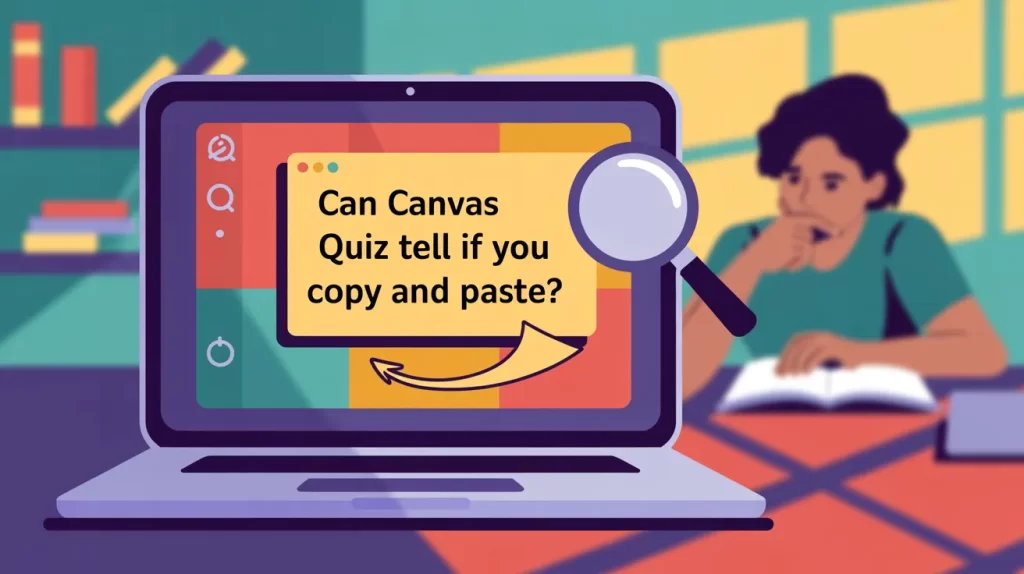Table of Contents
Canvas, a widely used learning management system, is known for its suite of tools designed to maintain academic integrity and prevent cheating during online exams. One common concern among students is whether Canvas can detect copy-paste actions during quizzes.
In this guide, we’ll explore how Canvas monitors quiz activities, the tools it uses to detect cheating, and the steps you can take to ensure your work is original.
How Canvas Monitors Quiz Activity
Canvas uses several tools to monitor quiz activity and maintain the integrity of assessments. The two primary methods Canvas employs are Quiz Logs and integrated third-party tools such as Turnitin and Copyleaks.
Canvas Quiz Log Explained
The Canvas Quiz Log tracks detailed student activity during quizzes. This log records mouse clicks, keystrokes, tab switching, and even inactivity. If a student switches tabs during a quiz, for example, it gets logged and can be flagged by the instructor as potentially suspicious behavior.
Does Canvas Record Copy-Paste Actions?
While the Quiz Log tracks tab switching and inactivity, Canvas does not directly track the act of copying and pasting. However, certain plagiarism detection tools integrated with Canvas, such as Turnitin and Copyleaks, can identify copied text or similar content across different submissions.
What Your Instructor Can See in Quiz Analytics
Instructors can view a detailed activity log that shows when a student accesses or exits a quiz, time spent on each question, and even specific attempts to switch tabs. Suppose a student copies and pastes answers from external sources. In that case, instructors might notice an abnormal pattern of activity, such as long periods of inactivity or multiple switches to a different browser window.
Tools That Help Canvas Detect Copying
Canvas integrates a variety of third-party tools that enhance its ability to detect cheating and plagiarism. These tools provide additional layers of detection and monitoring for both text-based plagiarism and AI-generated content.
Turnitin for Text Plagiarism
Turnitin is one of the most widely used plagiarism detection tools, and it’s integrated within Canvas. Turnitin compares submitted text to a vast database of academic papers, articles, and internet sources to identify similarities. If you copy-paste content from external websites or other students’ submissions, Turnitin will flag these matches in a Similarity Report, which instructors can use to assess academic integrity.
Copyleaks for AI-Generated Content
Copyleaks is another tool integrated with Canvas to detect plagiarism. Still, it has an added advantage—it can identify AI-generated content, such as answers produced by tools like ChatGPT or other automated content generators. This makes Copyleaks particularly useful for detecting cheating using AI-written text during assessments.
LockDown Browser & Screen Recording
For exams that require higher levels of security, Canvas integrates the LockDown Browser. This browser restricts your ability to navigate away from the quiz, copy and paste, or open new tabs. It also records your screen activity, ensuring that no external resources are accessed during the test.
Common Myths About Cheating Detection in Canvas
There are many myths and misconceptions about how Canvas detects cheating. Let’s address some of the most common ones.
“Canvas Knows Everything You Do”—Is It True?
While Canvas does monitor certain activities during quizzes, such as tab switching, it does not track every single action you take. It cannot detect if you’re using a second screen or a different device unless integrated proctoring tools are used.
Does Canvas Detect Split-Screen Use?
Canvas cannot detect split-screen use without the help of proctoring tools like Proctorio or LockDown Browser, which monitor your screen activity more closely. Without these tools, Canvas cannot see if you’re using multiple windows on your screen.
Can You Use ChatGPT Without Getting Caught?
Canvas does not have specific built-in features to detect AI-generated answers directly. However, tools like Copyleaks can identify AI-written content. Instructors may also spot unnatural language patterns or inconsistencies in style, which could raise suspicions.
Tips for Students: How to Stay Safe and Original
To avoid detection and maintain academic integrity, it’s essential to submit your work and avoid relying on external sources.
Use Original Content or Properly Cited Sources
Always write your answers or properly cite external sources. If you must reference external material, ensure it’s quoted or paraphrased correctly with proper citations.
Avoiding AI Detectors: Write Like a Human
If you’re using AI tools like ChatGPT to generate content, ensure the writing is edited and adjusted to reflect your personal style. AI-generated text often lacks the nuance and flow of human writing, which makes it detectable.
How to Check Your Work with Copyleaks
Before submitting your quiz or assignment, use Copyleaks or Turnitin (if available) to check for any potential plagiarism. This allows you to catch issues before your instructor does.
Instructor Tips: Enabling Cheating Detection
For instructors, Canvas offers several ways to ensure quizzes are secure and plagiarism-free.
Enabling Turnitin in Assignments & Quizzes
To activate Turnitin for quizzes, navigate to the Assignment Settings and enable Turnitin for text-based assignments. This will automatically generate a Similarity Report for each submission.
Setting Up LockDown Browser
If you’re concerned about cheating during online assessments, consider requiring students to use LockDown Browser. This tool locks the browser to prevent students from navigating away from the quiz or accessing other materials.
Read also: Duaction
Monitoring Canvas Quiz Logs for Suspicious Behavior
Review the Quiz Log to spot unusual patterns of activity, such as excessive tab switching, unusually fast responses, or long pauses between questions. This can help identify potential cheating attempts.
Final Words
Canvas offers a variety of tools and features that can help detect cheating, including Quiz Logs, Turnitin, Copyleaks, and LockDown Browser. However, students must understand the importance of academic integrity and avoid relying on copy-paste methods or AI-generated content.
By following best practices for originality and understanding how Canvas monitors quiz activity, you can ensure that your work is both honest and secure.
People Also Ask:
Can Canvas detect when I copy from Google?
Canvas does not directly detect if you copy text from Google or other websites, but plagiarism detection tools like Turnitin or Copyleaks will identify copied content in your submission.
Will pasting ChatGPT content get flagged?
Yes, if Copyleaks is integrated, ChatGPT-generated content will be flagged as AI-generated text. Even if you copy and paste content, it can still be detected through these tools.
Can instructors see if I switch tabs?
Yes, Canvas records tab switching during a quiz. Instructors can view this data in the Quiz Log, which may raise red flags if they see excessive tab switching.






